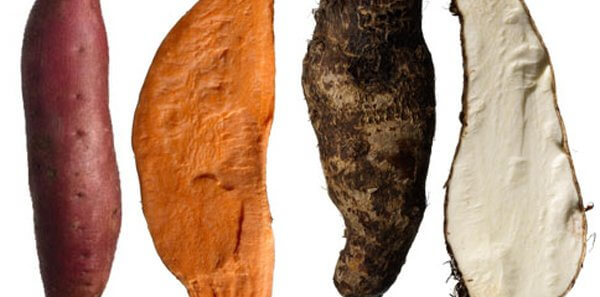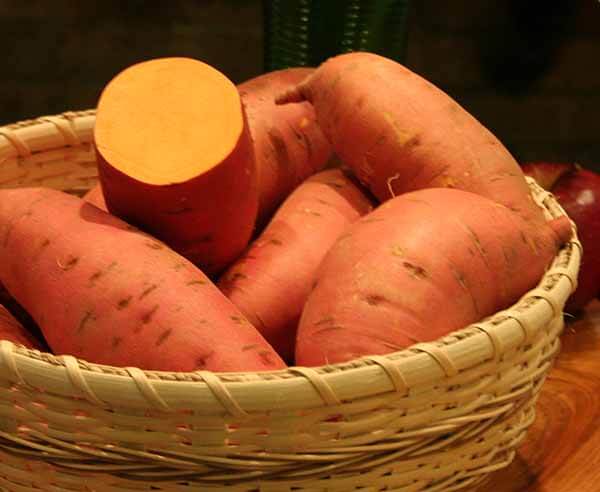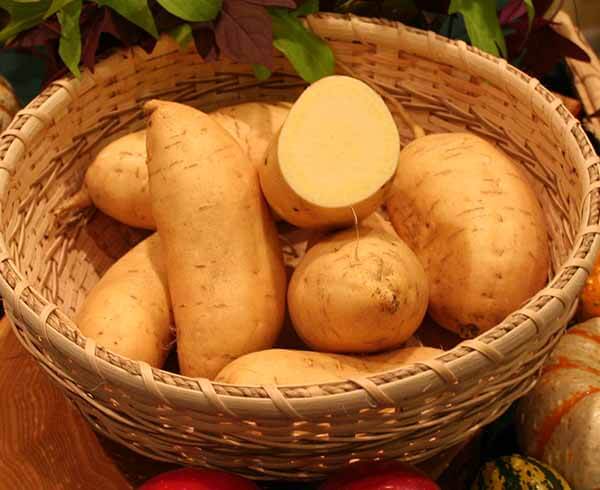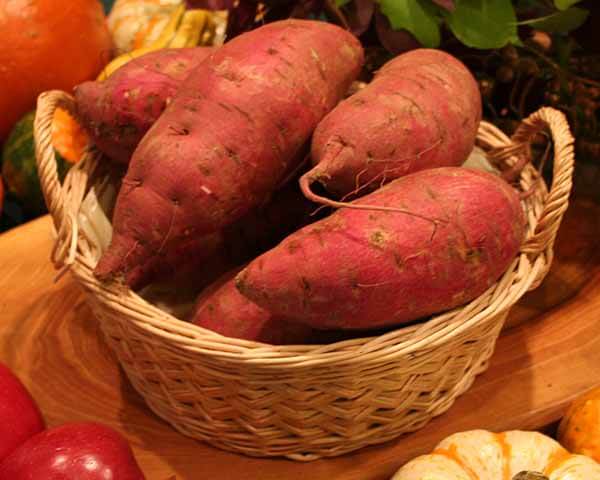History of Sweetpotatoes
Sweetpotatoes are as American as apple pie! Native Americans were growing sweetpotatoes when Columbus came in 1492, and by the 16th century, sweetpotatoes were being cultivated in the southern states, where they became a staple in the traditional cuisine. With their delicious sweetness and mild flavor, sweetpotatoes take to a variety of ethnic seasonings, making them a go-to ingredient no matter what the season.
From Southern to Thai, Caribbean to BBQ, sweetpotatoes are used in cuisines all over the world as a satisfying and versatile vegetable with a well-earned reputation for being nutritious.
What is the Difference between Sweetpotatoes and Yams?
Did you know a sweetpotato is not a yam? Learn the differences and share your fun facts around the dinner table!
Here’s the final answer to sweetpotatoes vs. yams—and why they’re so frequently confused for each other.
What’s in a name? When it comes to the yam, a bit of confusion. The truth is, what you’ve been calling a “yam” is most likely a sweetpotato. In fact, it’s quite possible that you’ve never even tasted a yam.
The so-called “yams” you see in the supermarket produce section are nearly always sweetpotatoes. Most people think that long, red-skinned sweetpotatoes are yams, but they really are just one of many varieties of sweetpotatoes.
So where did all of the confusion come from about sweetpotatoes vs. yams? Let’s break down the main differences between yams and sweetpotatoes so you can spot—and taste—the difference.
Sweetpotatoes vs. Yams
“Sweetpotato” and “yam” are often used as synonyms in recipes, conversations, and even at the grocery store. They are actually two totally different plants, though, and even belong to different plant families. Here’s how to tell them apart.
What Are Sweetpotatoes?
The sweetpotato is a member of the morning glory family and is botanically classified in the genus Ipomoea batata. The vines that sweetpotatoes grow on are native to Central and South America. Today, sweetpotatoes are propagated around the world. (In case you were curious, in the U.S., North Carolina is the number one sweetpotato-producing state.)
Sweetpotatoes are harvested in the fall but can be purchased year-round thanks to a curing process post-harvest that helps extend their life for more than a full year. You can find fresh sweetpotatoes in the produce section, of course, as well as pre-peeled and cooked varieties of sweetpotatoes in purée or frozen forms.
There are four main flesh and skin color combinations of sweetpotatoes available in America (see “The Bottom Line About the Differences Between Sweetpotatoes and Yams“ below for more). Some of the most popular sweetpotato varieties include Covington, Japanese, and White. They’re slim and tapered with fairly thin, edible skin. Sweetpotatoes offer a dose of natural sweetness and are about 77% water.
Sweetpotato recipes range from savory to sweet, and the spud can be baked, mashed, fried, grilled, soup-ified, casserole-d, or gnocchi-ed. In the puréed form, sweetpotatoes are popular in baked goods providing more moisture and making the dish elevated in ways you can not even image!
What Are Yams?
True yams are relatives of lilies. They are the starchy edible root of the Dioscorea batatas genus. More than 150 varieties of yams are available worldwide, and are especially popular in West African, Latin American, and Caribbean cuisine (and now beyond). Yams are usually imported to the U.S. since they thrive in climates more tropical than we experience.
Less sweet, often larger, and always starchier than sweetpotatoes, yams are about 70% water. They have a shelf life of about 6 months after harvest. Yams are shaped more like logs than tapered, a la sweetpotatoes, and they have thick skin that’s either smooth, tufted with hairs, or streaked.
Stateside, we only see a sliver of the world’s yam varieties. White yams are most common here, and you might see purple yams (AKA ube). The latter are different from purple sweetpotatoes, by the way.
For culinary purposes, yams are almost always cooked, since they may contain toxins that can only be destroyed by heat. Once cooked, yams are mildly-flavored, slightly sweet, and nutty. Texture-wise, yams range from soft and crumbly to fibrous and waxy. They can be featured in a wide variety of recipes, including stews, mashes, soups, and roasts, and also make terrific chips and fufu (a dough-like starch that’s used as a utensil of sorts to scoop up other dishes).
So Why Do So Many People Think Sweetpotatoes Are Yams?
Depending on the variety, sweetpotato flesh can vary from white to orange and even purple. The orange-fleshed firmer variety was formally introduced to the United States in 1937. In order to distinguish it from the white softer variety most people were accustomed to at the time, producers and shippers chose the English form of the African word “nyami,” “njam,” or “djambi” (which means “to eat) and labeled them “yams.” Basically, the uncertainty about yams and sweetpotatoes all boils down to some slick marketing.
These two types of sweetpotatoes do have some notable variability.
- Firm orange-fleshed: Often marked as “sweetpotatoes;” remain firmer and waxy after cooking
- Soft paler-fleshed: Often marked as “yams;” turn more creamy and fluffy after cooking
Today the U.S. Department of Agriculture requires labels with the term “yam” to be accompanied by the term “sweetpotato.” Despite the label regulations, most people still conflate sweetpotatoes and yams, regardless of their true identity.
The confusion about what are yams, really? persists around the world. In Malaysia and Singapore, for instance, “yam” is the term used for taro (yet another root). And in New Zealand, oca tubers are called “yam.”
The plot thickens even more in the U.S. when you stroll over to the canned food aisle. The canned candied yams you see on store shelves are actually sweetpotatoes. If you search for “candied yam” recipes online, it’s almost guaranteed to turn up millions of sweetpotato recipes.
We’re not ones to nitpick and realize that terms evolve over time. But to steer clear of any misunderstandings, keep these sweetpotato and yam differences in mind so you can shop and cook smarter
The Bottom Line About the Differences Between Sweetpotatoes and Yams
Now that you know why sweetpotatoes and yams are different, as well as where the confusion comes from, let’s have a speed round version to highlight the similarities and differences between these two root vegetables.
Taste
- Sweetpotatoes are almost always sweeter than yams.
- Yams are starchier and more potato-like; usually not very sweet.
Appearance
- Sweetpotatoes are generally more slender in appearance than a russet potato and have tapered ends. In the U.S., the majority of sweetpotatoes sold are one of four hues, each with a different flavor profile:
- Rose-colored skin with orange flesh
- Pale copper-tan skin with white flesh
- Red skin with dry white flesh
- Purple skin and flesh
- Yams vary considerably in appearance. Some are the size and shape of small potatoes; others can grow up to 1 ½ meters (5 feet) in length and weigh over 100 pounds (70 kilograms). Skins may be dark brown or light pink, while the flesh is white, yellow, purple, or pink.
Nutrition
- Sweetpotatoes have more sugar, protein, calcium, iron, sodium, vitamin A, beta-carotene, and water than yams do. (In case you missed it, here are 5 major health benefits of sweetpotatoes.) According to the USDA, 1 cup of raw sweetpotatoes delivers:
- 114 calories
- 0 g fat
- 2 g protein
- 27 g carbohydrates
- 4 g fiber
- 3 mg vitamin C
- 40 mg calcium
- 33 g magnesium
- Yams have more carbs, fiber, potassium, vitamin C, vitamin B6, vitamin E, and slightly more fat than sweetpotatoes do. The USDA confirms that 1 cup of raw yams offers:
- 177 calories
- < 1 g fat
- 2 g protein
- 42 g carbohydrates
- 6 g fiber
- < 1 g sugar
- 25 mg vitamin C
- 26 mg calcium
- 31 mg magnesium
Production
- Sweetpotatoes are grown around the world. More than 50% of the American-grown sweetpotatoes are harvested in North Carolina.
- Yams are grown around the world, but West Africa is still where most yam crops (nearly 95%) are grown.
If all this sweet talking has you inspired to try something new, dig into our 52 ways to love sweetpotatoes series. It offers easy, delicious inspiration for every week of the year!
Think you know the differences between yams and sweetpotatoes? Take our quiz and test your root knowledge!
Covington, White, Japanese? Orange, Yellow, Purple? The many shapes, sizes and colors of sweetpotatoes share the story behind the many varieties of sweetpotatoes available today. The challenge? How to choose!
There are hundreds of types of sweetpotatoes ranging from white and mild to deep red and super sweet. Many are grown in small quantities and can be found at local farmers markets. Lucky for you, North Carolina sweetpotatoes are available every month of the year. When selecting sweetpotatoes, it is important that they are firm to the touch and no signs of decay. For even cooking, choose sweetpotatoes that are uniform in shape.
The following are three popular sweetpotato varieties found in grocery stores nationwide. Depending on flavor and texture, certain sweetpotato varieties lend themselves better for certain recipes.
Covington Sweetpotato
A favorite for mashing or roasting, the Covington Sweetpotato has rose colored skin and supersweet orange flesh. Eat it whole with your favorite toppings or cut into wedges and bake as a side dish.
White Sweetpotato
This white Sweetpotato has a pale copper skin, almost like a potato, but don’t be fooled. This tater’s white flesh is sweet, creamy and ideal for soups and stews.
Murasaki/Japanese Sweetpotato
Murasaki sweetpotatoes have red skin and dry, white flesh. Roast these up with a few of your favorite root veggies for a colorful side dish.
Many types of sweetpotatoes are grown in North Carolina. Although some are grown for special uses, the majority are the orange-fleshed, moist, sweet varieties that are widely accepted in the fresh market and for processing. The list of sweetpotato varieties changes rapidly and new varieties with superior qualities are released almost annually. Each variety has certain advantages and disadvantages.
Now that you’ve found your spud of choice, don’t spoil it at home! Learn the tricks to sweetpotatoes so you know where you should and should not store your taters.




